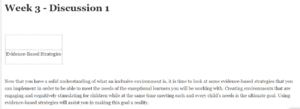Week 3 – Discussion 1

| Evidence-Based Strategies |
Now that you have a solid understanding of what an inclusive environment is, it is time to look at some evidence-based strategies that you can implement in order to be able to meet the needs of the exceptional learners you will be working with. Creating environments that are engaging and cognitively stimulating for children while at the same time meeting each and every child’s needs is the ultimate goal. Using evidence-based strategies will assist you in making this goal a reality.
To prepare for this discussion,
· Please refer to the Week Three Guidance for further tips and examples that will support your success on this discussion.
· Review textbook Chapter 2: Teaching Students in Special Education.
· Choose one of the evidence-based strategies groups below that is interesting to you and review the provided resources.
In your post,
· Put the names of the two evidence-based strategies you chose from the table above in the subject line of your post.
· Compare and contrast the two evidence-based strategies you were assigned.
· Explain the importance of using evidence-based strategies to assist all children’s success in an inclusive learning environment.
· Synthesize how you could use the two evidence-based strategies together in order to meet the needs of diverse learners in your learning environment.
Week 3 – Discussion 2
| Universal Design for Learning |
Along with the evidence-based strategies you learned about in the first discussion forum this week, one of the most widely regarded strategies for meeting the needs of the children you work with is Universal Design for Learning or UDL. According to the National Center on Universal Design for Learning, “UDL provides a blueprint for creating instructional goals, methods, materials, and assessments that work for everyone—not a single, one-size-fits-all solution but rather flexible approaches that can be customized and adjusted for individual needs” (2014, para. 2). After completing this discussion you will have a solid understanding of UDL.
To prepare for this discussion,
· Please refer to the Week Three Guidance for further tips and examples that will support your success on this discussion.
· Complete the Iris Center module: Universal Design for Learning: Creating a Learning Environment that Challenges and Engages All Students (Links to an external site.)Links to an external site. .
In your post,
· Describe, in your own words, Universal Design for Learning. Make sure to explain each of the three principles of UDL.
· Summarize, based on the age of children you plan to work with, the three main considerations you will need to be mindful of when implementing the principles of UDL in your work.
· Explain one challenge that you see when implementing UDL in your future educational setting. Be sure to include one possible solution to that challenge, and explain how collaboration with others will factor into the solution.